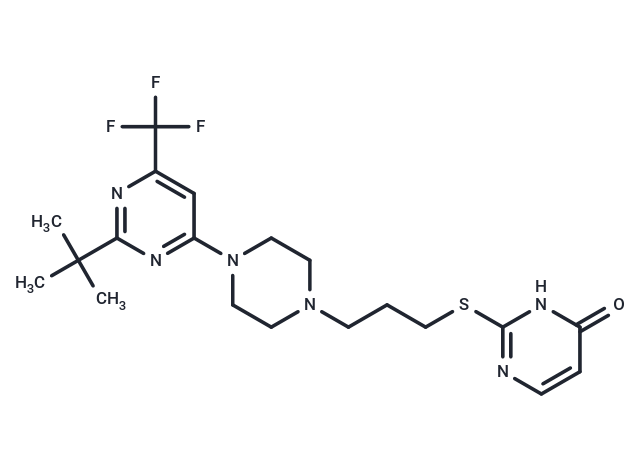Shopping Cart
Remove All Your shopping cart is currently empty
Your shopping cart is currently empty
A-437203 (Lu201640) is A kind of based on 1 h - pyrimidin - 2 - one sca ff old, selective, new powerful d3 receptor antagonist, on D2, d3, and D4 receptor, Ki value 71, respectively 1.6 and 6220 nM.

| Pack Size | Price | USA Warehouse | Global Warehouse | Quantity |
|---|---|---|---|---|
| 1 mg | $91 | In Stock | In Stock | |
| 5 mg | $209 | In Stock | In Stock | |
| 10 mg | $293 | In Stock | In Stock | |
| 25 mg | $457 | In Stock | In Stock | |
| 50 mg | $592 | In Stock | In Stock | |
| 100 mg | $822 | In Stock | In Stock | |
| 200 mg | $1,090 | - | In Stock | |
| 1 mL x 10 mM (in DMSO) | $239 | In Stock | In Stock |
| Description | A-437203 (Lu201640) is A kind of based on 1 h - pyrimidin - 2 - one sca ff old, selective, new powerful d3 receptor antagonist, on D2, d3, and D4 receptor, Ki value 71, respectively 1.6 and 6220 nM. |
| Targets&IC50 | D2 receptor:71 nM (Ki), D4 receptor:6220 nM , D3 receptor:1.6 nM |
| In vitro | A-437203 is a high-affinity antagonist for D3 receptors with 44-fold selectivity over D2 receptors, demonstrating relatively high selectivity among dopamine receptor subtypes[1]. |
| In vivo | A-437203 is initially tested alone in the rat forced swim test (FST). Doses of A-437203 evaluated are 0.52, 1.75, 5.24, and 17.46 μmol/kg i.p. Doses are chosen based on the selectivity of A-437203 for D3 vs D2 dopamine receptors and reports indicating that the effects of A-437203 at doses of 17.46 μmol/kg (10 mg/kg) or lower are clearly mediated by D3 but not D2 receptors since higher doses of the compound such as 174.6 μmol/kg (100 mg/kg) are necessary to bind and block D2 receptor from the irreversible inactivation induced by the alkylating agent EEDG. ANOVA revealed no significant difference between the treatments for any of the behaviors analyzed (F4, 45=1.12, p=0.359 for immobility, F4, 45=0.188, p=0.943 for climbing, and F4, 45=1.634, p=0.182 for swimming). Based on these results, the dose of 17.46 μmol/kg i.p. of A-437203 is selected for further experiments[1]. |
| Animal Research | Male Sprague-Dawley rats weighing 250-350 g are used for these experiments. Haloperidol (0.27, 1.33, and 2.66 μmol/kg=0.1, 0.5, and 1.0 mg/kg i.p.), A-437203 (LU-201640) (0.52, 1.75, 5.24, and 17.46 μmol/kg=0.3, 1.0, 3.0, and 10.0 mg/kg i.p.), and L-745,870 (0.23, 1.15, 2.3, and 5.7 μmol/kg=0.1, 0.5, 1.0, and 2.5 mg/kg i.p.) are tested initially alone in order to determine effective dose ranges. In those experiments, haloperidol, A-437203, and L-745,870 are administered i.p. 24, 5, and 0.5 h before the test swim. In the subsequent antagonism experiments, Haloperidol (0.27 μmol/kg), A-437203 (17.46 μmol/kg) or L-745,870 (1.15 μmol/kg) are injected i.p. 15 min prior to each quinpirole injection (0.4 and 1.0 μmol/kg s.c.). |
| Synonyms | Lu201640, ABT-925, A37203 |
| Molecular Weight | 456.53 |
| Formula | C20H27F3N6OS |
| Cas No. | 220519-06-2 |
| Smiles | C(F)(F)(F)C1=CC(=NC(C(C)(C)C)=N1)N2CCN(CCCSC=3NC(=O)C=CN3)CC2 |
| Relative Density. | 1.35 g/cm3 (Predicted) |
| Color | White |
| Appearance | Solid |
| Storage | Powder: -20°C for 3 years | In solvent: -80°C for 1 year | Shipping with blue ice/Shipping at ambient temperature. | |||||||||||||||||||||||||||||||||||
| Solubility Information | DMSO: 60 mg/mL (131.43 mM), Sonication is recommended. | |||||||||||||||||||||||||||||||||||
Solution Preparation Table | ||||||||||||||||||||||||||||||||||||
DMSO
| ||||||||||||||||||||||||||||||||||||
| Size | Quantity | Unit Price | Amount | Operation |
|---|

Copyright © 2015-2026 TargetMol Chemicals Inc. All Rights Reserved.